Martin Kysel and Amy Fox bought a GMC 2500 and Palomino SS-1200 pop-up and almost immediately shipped it to Chile. With their first RV, and for their maiden long-distance trip, they dove into the deep end of the international adventure pool. Buckle up fellow boondockers. This story pushes limits.
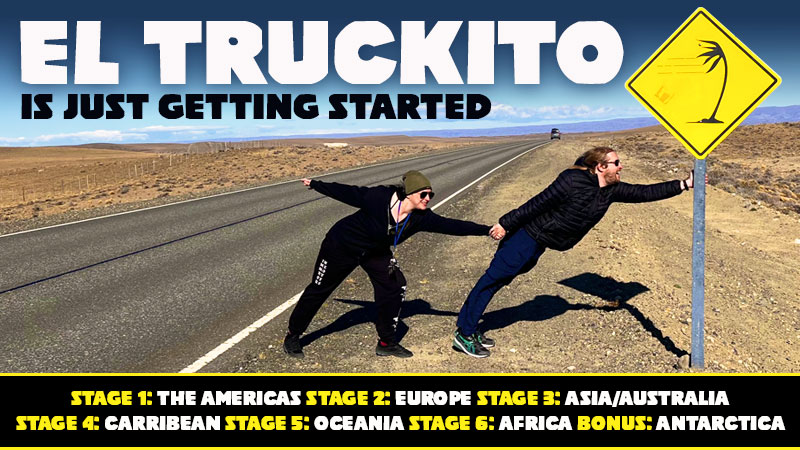
Think back to the moment when you got your first truck and camper rig. For us that was 2005 and we had no idea what we didn’t know. Parked in my grandparent’s driveway, we literally called the camper dealership to ask how the water heater turned on, and almost melted an extension cord powering the air conditioner. Perhaps you can relate to that initial feeling of discovery and trepidation in your early truck camping days.
Martin Kysel and Amy Fox bought their first RV of any kind, a 2016 GMC Sierra 2500 and a 2016 Palomino SS-1200, in 2022 and immediately shipped it to Chile. A few days later they followed without much in the way of truck camping or long-distance travel experience. In their early days of truck camping, they were in another country and continent thousands of miles from home.
Fortunately, Martin and Amy are no ordinary duo. These two quickly learned to adapt and push through the inevitable challenges of truck camping. Language barriers, mechanical breakdowns, and even medical emergencies have all been encountered, endured, and overcome. Just as important, they have seen things in South America few people ever experience; Chilean Patagonia, Argentinian Patagonia, the Uyuni Salt Flats in Bolivia, and beyond.
If everything goes according to Martin and Amy’s plan, all of this will be the first chapter, Stage 1 on their website, of their world traveling master plan. Stages 2 through 6 include Europe, Asia and Australia, The Caribbean, Oceania, Africa, and Antarctica. And we think we’re aiming high taking our rig to Nova Scotia or Mexico. We are inspired, and a bit overwhelmed by Martin and Amy’s willpower, gumption, and vision. El Truckito is just getting started.
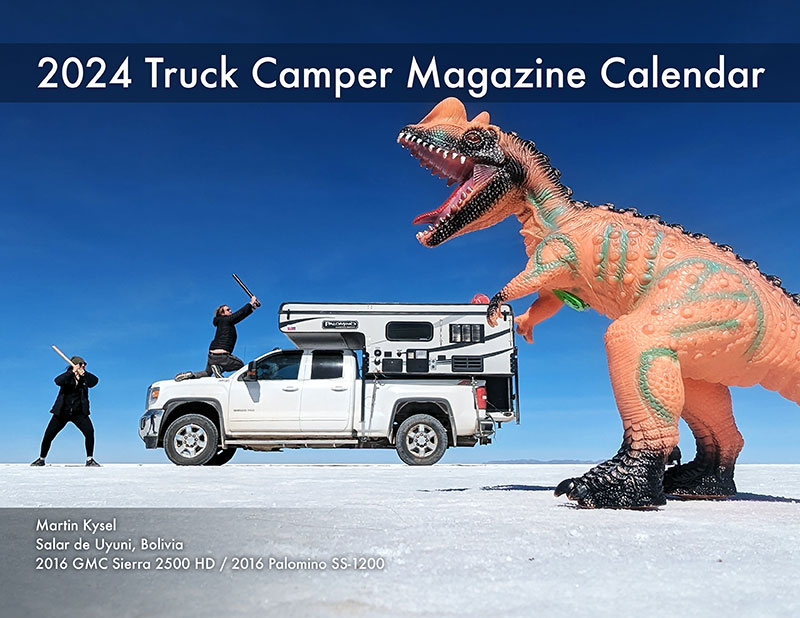
Above: Martin Kysel’s spectacular 2024 TCM calendar winning entry
How did you end up living on the road and traveling on a different continent?
It all began with pandemic boredom. We started road-tripping around the United States and sleeping in the trunk of Martin’s Mazda 6 during the summer of 2020. Then, Martin had an idea. He said, “We should do this in South America.” We were working remotely anyway, so who said we had to be in our apartment?
In 2021 we started looking for our perfect vehicle and ultimately settled on a truck camper rig. Our goal was to ship it to South America in autumn 2022.
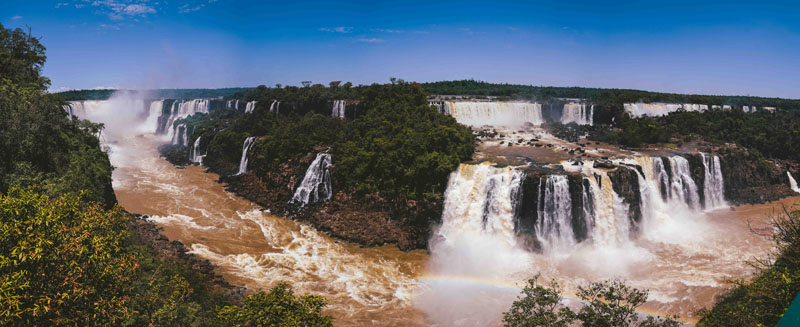
Above: Iguazu waterfalls, Argentina and Brazil
That’s incredibly audacious. Why did you want to explore South America? Why not start with Europe, Asia, Africa, or Australia?
We plan to do the other continents eventually, but we had our hearts set on South America. Spanish is the official language of the majority of countries in both North and South America, which makes communication far easier than in Asia, for example. Crossing borders with vehicles is also a much easier procedure and cheaper in South America than in most continents.
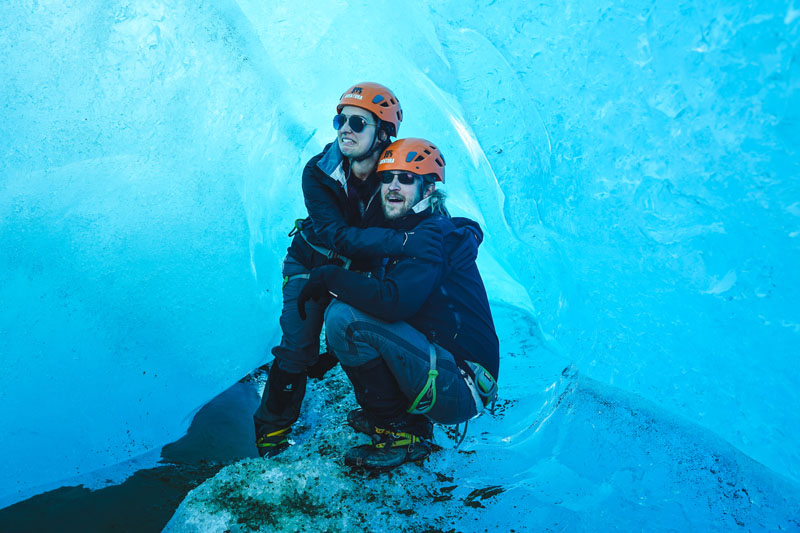
Above: Inside a glacier in Chile
That makes sense. How did you prepare for this huge life change?
Short answer; you don’t! We were overwhelmed at first. Unless you already speak the language of the country you’re landing in, you will find the language challenges overwhelming at first. You have to learn how to navigate a new tongue, new customs, and, in many cases, aspects of your everyday life.
In some countries, you are not allowed to pump your gas or, if you need more propane, you can’t just go and exchange the bottle. Additionally, once you get used to one country, you’ll inevitably have to adapt to the next. Driving habits vary from country to country. Anyone familiar with driving in the northeastern United States will find driving in a country like Chile or Argentina to be relatively straightforward. However, there is no amount of preparation you can have for the driving habits in Bolivia where driver’s education is quite literally non-existent.
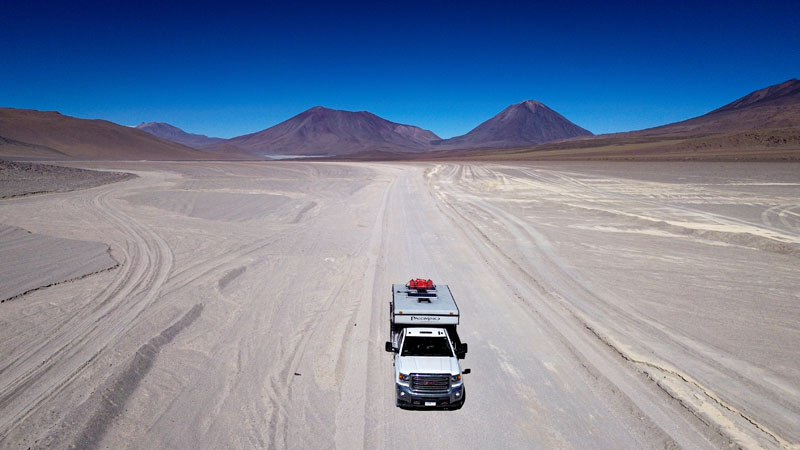
Above: Deserted Road, Laguna Route, Bolivia
That could be terrifying. Why did you choose a Palomino camper?
It was available. When we began looking for campers in 2021, there were few options, particularly on the East Coast. We even visited dealerships in other states only to be told that no matter what we wanted to order, it would be an 18 month wait. Our Palomino was the only truck camper we could find within a reasonable driving distance from our residence at the time.
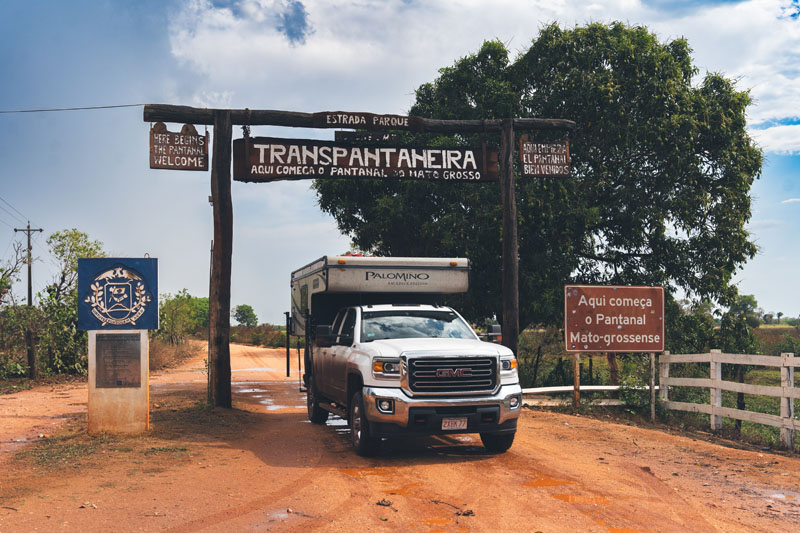
Above: Entrance to Transpantaneira Highway in Brazil
People take hard sides and pop-ups to South America. Has having a pop-up been advantageous?
Not being tall has been useful. Occasionally we will encounter height restrictions on the road, whether it’s a bridge or the gate to a campground. However, the canvas pop-up walls are not ideal for some of the climate zones we have found ourselves in. We experienced a lack of heat retention during subfreezing temperatures in the Bolivian Altiplano, and it was intolerably hot and humid in the Brazilian Pantanal where the daytime temperatures were nearly 110 degrees.
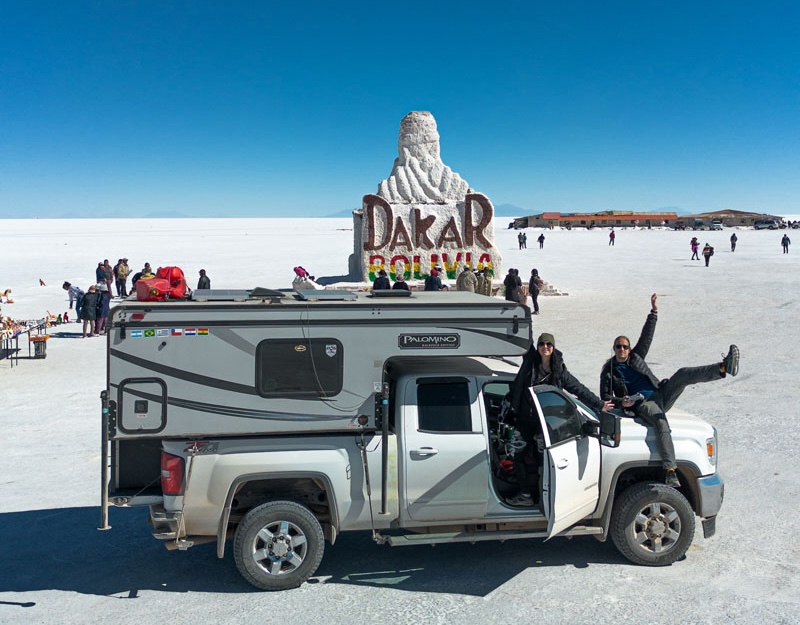
Above: Dakar Monument in Uyuni, Bolivia
Those extremes would be challenging for any camper. Where did the name El Truckito come from?
We had just begun our journey in Chile and it occurred to us that everyone names their vehicle. Martin came up with the absurd suggestion of, “El Truckito” (a Spanish diminutive for “the little truck”) for our hefty beast of a truck. It’s clearly a winner as more than a year after hitting the road it still elicits chuckles from anyone who learns our truck’s name.
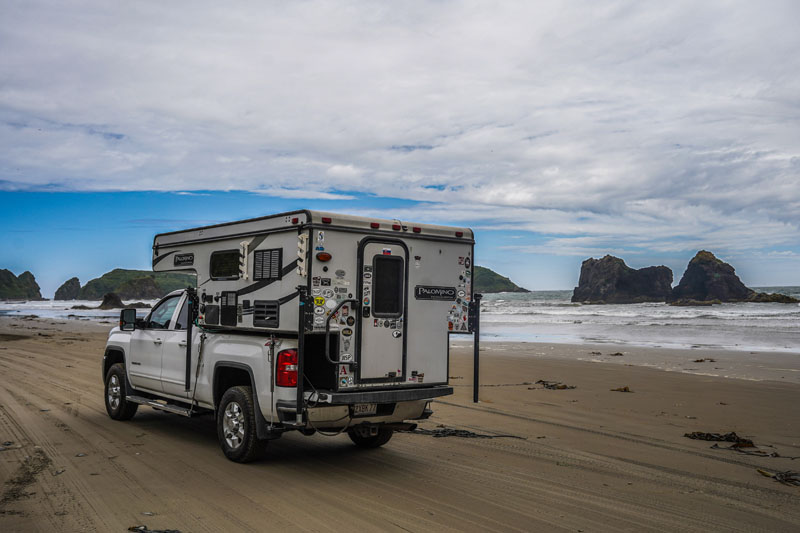
Above: Pacific Ocean, Chiloe Island, Chile
Tell us how you got your rig to South America.
We began our journey by driving from Boston to Galveston, Texas. We shipped El Truckito from Galveston to Chile in October of 2022. We decided to begin in Chile because the window for tolerable weather in Patagonia is only during South American summer; between December and March. The truck officially left Galveston mid-November 2022 and arrived in Chile a few weeks later in December. We will be driving through Central America on our way back. Here’s the map of our route.
At the time of writing, we have been traveling for 15 months and are not close to being finished with South America. We still have several countries to go before we start Central America.
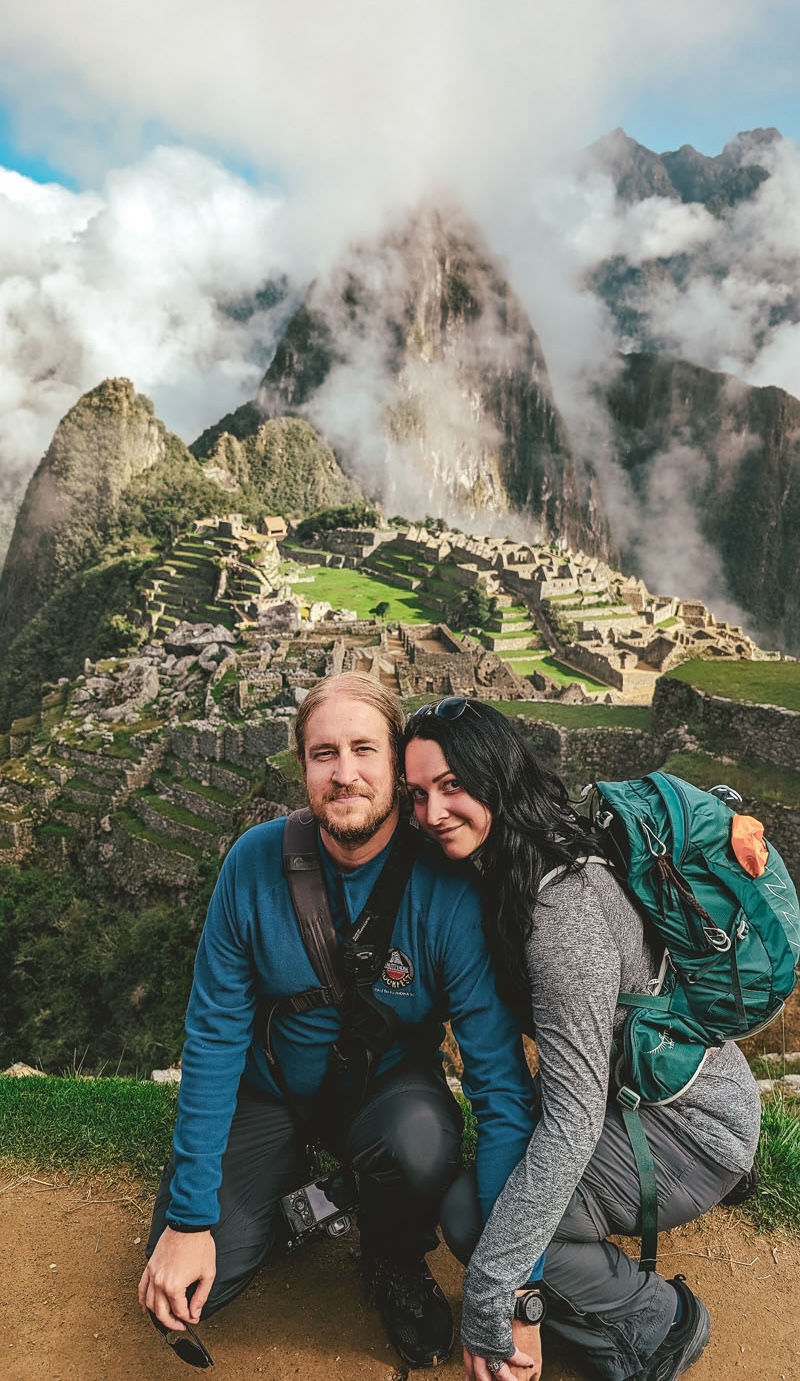
Above: Martin and Amy at Machu Picchu in Peru
That’s a long time to be away from family and friends. Have you gone home during your travels?
We have each traveled back home on brief visits to take care of personal or family business, always returning with spare truck or camper parts. We started our Instagram account specifically to show our family and friends what we were up to on the road. So far we’ve been pretty successful at communication.
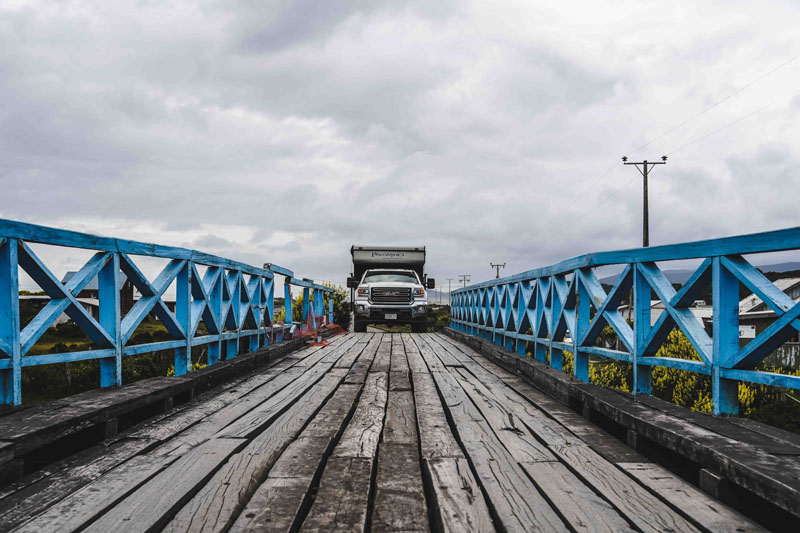
Above: Wonky bridge in Chiloe, Chile
What are the biggest challenges to traveling in South America?
There are many challenges to traveling in South America, especially as an overlander. The biggest obstacles we encounter are generally poorly maintained or unpaved roads, animals, protests, and police checkpoints on said roads, and, in many countries, exceptionally terrible drivers. These conditions can make ascertaining the time it will take to get to your next destination challenging.
“Traveling in South America requires more flexibility with your time and the patience to deal with unexpected problems.”
While overlanding is becoming more popular, especially in many South American nations, not all locations have facilities that can assist with our needs (water refilling or electrical hookups for example). Traveling here requires more flexibility with your time and the patience to deal with unexpected problems.
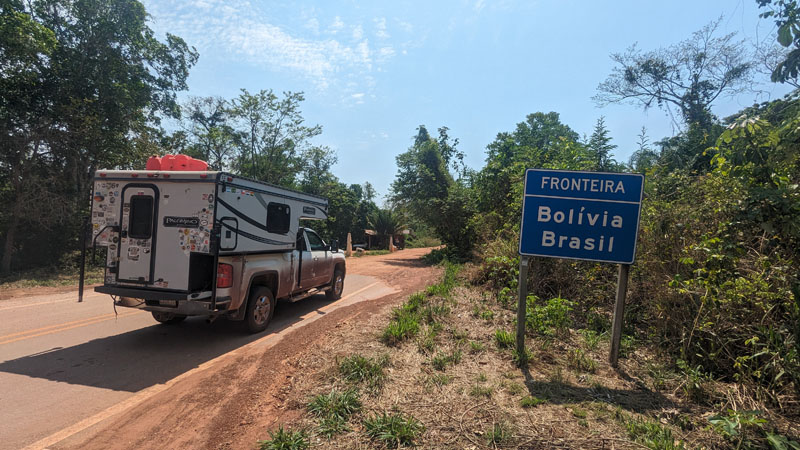
Above: The Border of Brazil and Bolivia
Have border crossings been an issue?
Surprisingly, border crossings here are far simpler than one might expect. There are very few differences in the requirements at each border. Once you’ve done it for the first time, you know how the routine works.
You get your passport stamped in one line, go to the next line or building, and then hand someone your vehicle’s papers so they can issue a temporary import permit for your vehicle. A few countries have their oddities like a ban on some foreign food products, certain insurance requirements for your vehicle, or drone bans.
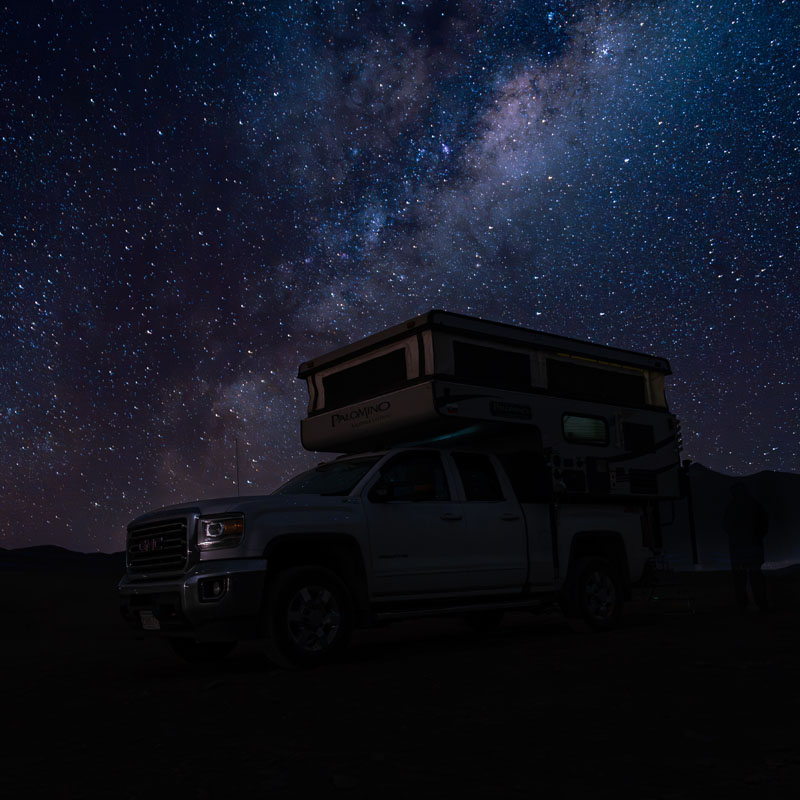
Above: Starry night, Atacama Desert, Chile
Where do you typically stay in your camper?
That’s where iOverlander is your friend. We use all three overnight camping categories; formal, informal, and wild. In cities, we stay in formal campgrounds since they feel inherently more secure. Gas stations are extremely popular as informal sleeping spots in South America. There are also some incredible places to wild camp. Some of our favorite memories so far have included boondocking in unusual locations like the Uyuni Salt Flats in Bolivia, the Peruvian Altiplano, and the Patagonian desert in Argentina.
“Some of our favorite memories so far have included boondocking in unusual locations like the Uyuni Salt Flats in Bolivia, the Peruvian Altiplano, and the Patagonian desert in Argentina.”
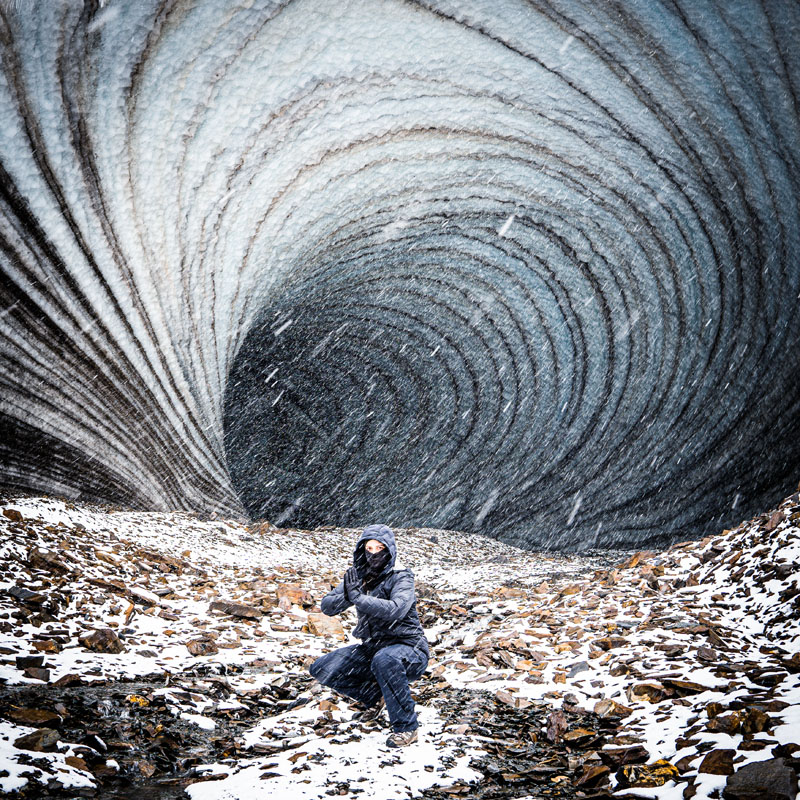
Above: Cueva del Jimbo, Argentina
That sounds amazing. Is there anywhere you have felt unsafe?
We follow the same rules here that we would follow when traveling in the United States. If we think somewhere looks unsafe, we don’t stop there. We’re always careful where we park and where we choose to sleep.
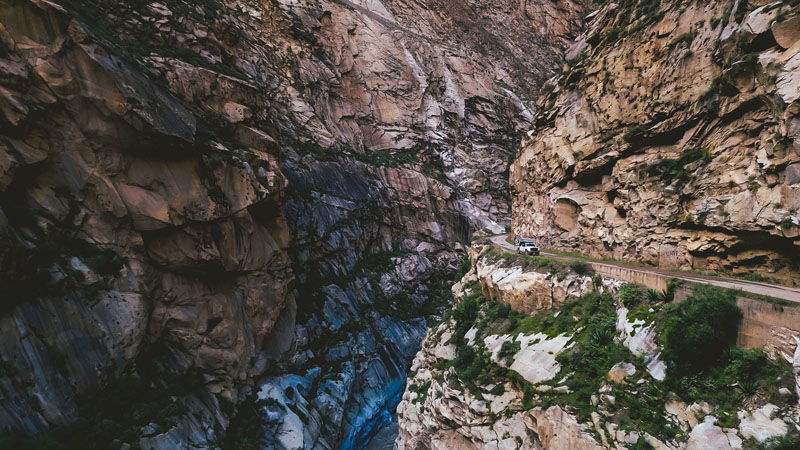
Above: Cañón del Pato, a dangerous road in Peru
Earlier you talked about challenges with the language. Has language been an issue?
We began studying Spanish well before we departed for South America and continue to have weekly lessons online to improve our skills. If you’re a native English speaker, Spanish is fairly easy to pick up. The majority of daily conversations that you will have on the road involve purchasing food or gas, so knowing numbers and how to ask for things is invaluable. It also makes life easier when it comes to paperwork at the border or any other issue you might have, such as needing to see a doctor.
The more of the language you know the more opportunities you have to meet the locals. We speak pretty decent Spanish so we don’t usually have issues, although this can be dependent on the dialect of the country.
Chile, for example, speaks a variant of Spanish heavily influenced by indigenous words. Chileans utilize slang to the point that it may as well be a separate language for us non-native speakers. Additionally, Spanish is not similar enough (for us) to Portuguese so we found getting around Brazil to be more difficult. In that instance, as English is not commonly spoken outside of major cities, we relied on Google Translate and the ten or so Portuguese words we figured out (most of which pertain to food).

Above: Baby alpaca and indigenous women in Cusco, Peru
What is something you packed that you never needed and something you didn’t pack that you needed?
Where do we even start? This is our first RV, our first truck camper, and our first large trip. We weren’t really covered in any of the basics such as power, water, and heating, and needed lots of adapters, hoses, connectors, and plugs.
We planned to bring less and see what we needed rather than bring excessive items that would just clutter the little space we have. We did bring a traction board which got destroyed the first time we attempted to use it. The plastic ones don’t seem to work if you are 9,000 pounds.
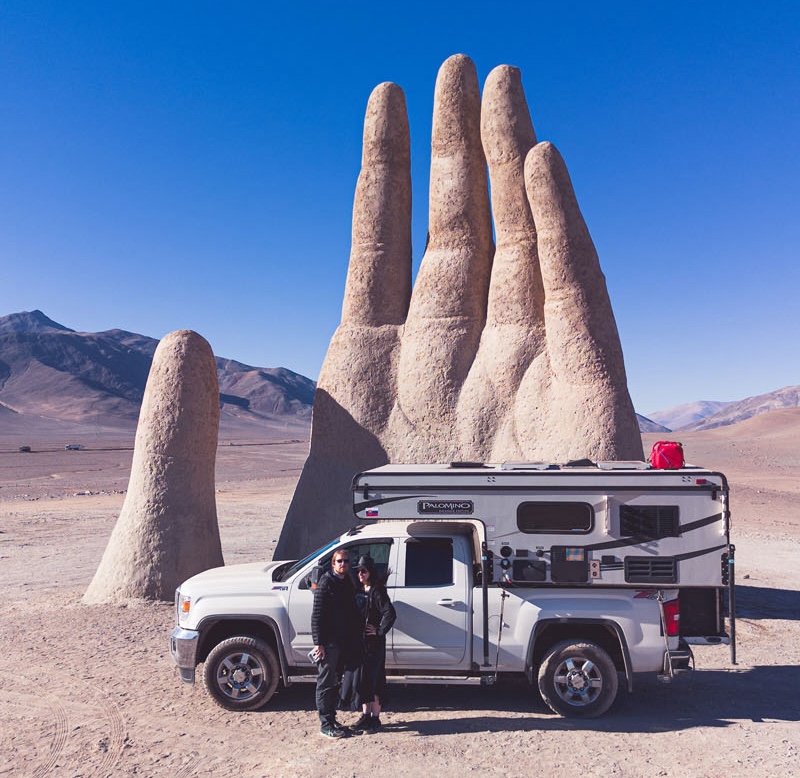
Above: Martin and Amy at Mano del Desierto, Chile
It’s crazy to think that you went to South America in a truck camper without much experience with RVs. You’re quite young to be full-time traveling. Are you working on the road?
Working and traveling at the same time is becoming increasingly popular with the younger overlanding crowd. Some travelers will play music or sell jewelry or bread to pay their way. A few highly motivated travelers can make it work with a successful YouTube channel. We both work remotely several days per week as a software engineer (Martin) and writer (Amy). Starlink is a game changer for those wanting to overland and work at the same time. You don’t need to be in a real camp to have internet and WIFI now. There’s nothing quite like working in the mountains or on a beach.
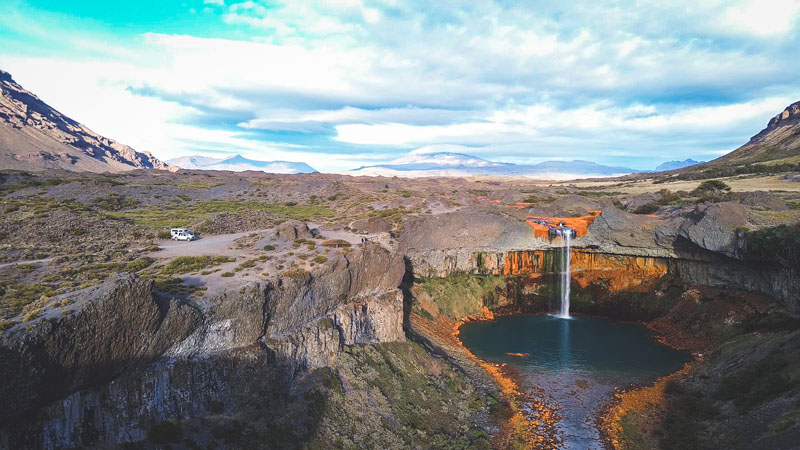
Above: Check out where they parked for the night! Sunrise at Agria waterfall in, Argentina
You definitely have a nice office view. What is a typical day for Martin and Amy like?
There is no typical day! If we could summarize a typical week, we find a place we’d like to stay for a few days to work, whether that’s a campground or a scenic spot in the middle of nowhere.
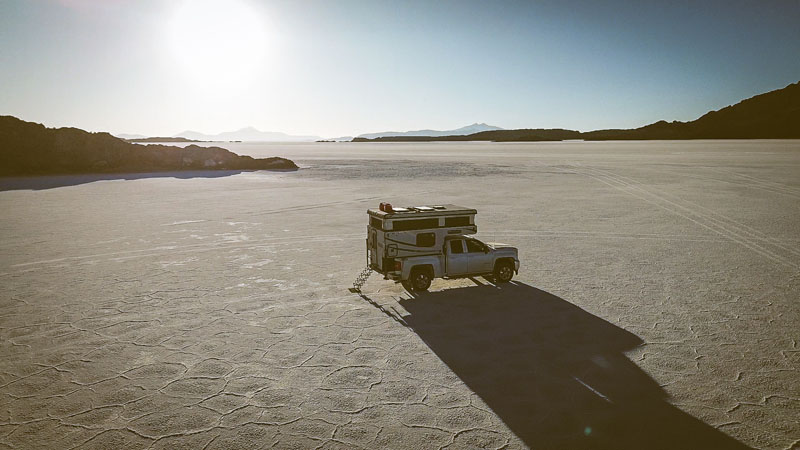
Above: Sunset at the Uyuni Salt Flats, Uyuni, Bolivia
Once we’ve finished our work for the week, we explore. There’s no typical amount of driving we do as this is entirely location-dependent. In a larger country, such as Argentina, this could mean we drive for several days. In a smaller country, such as Ecuador, it’s much easier to drive a little and explore a little on the same day.
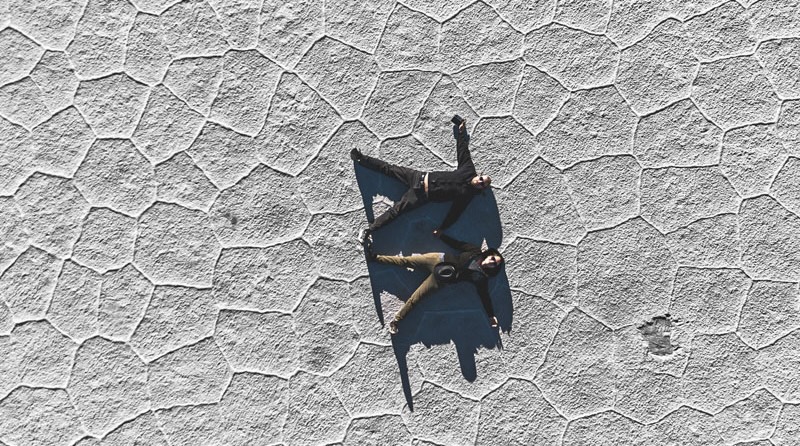
Above: Lying on Salinas Grandes Salt Flats in Argentina
After 15 months in South America, what are some of your most memorable moments?
The highs have been exploring the fragile ecosystems of Chilean Patagonia, desert camping in the vast and empty Argentinian Patagonia, driving on the Uyuni Salt Flats in Bolivia, and putting our truck on a cattle pontoon to travel through the Brazilian Pantanal.
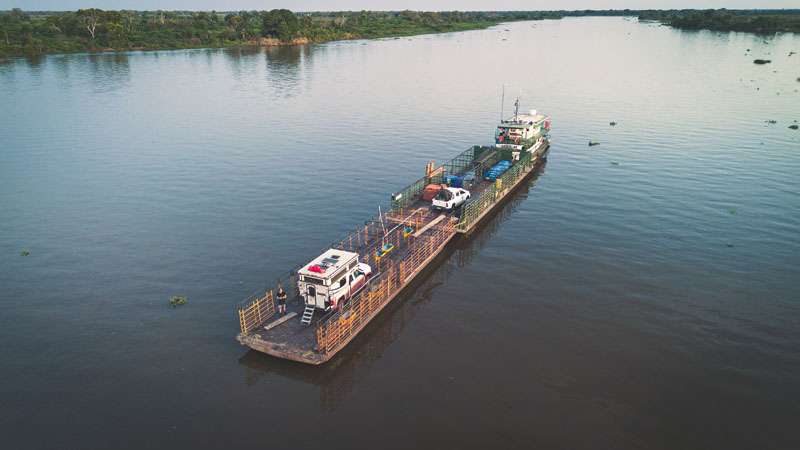
The lows have been destroying our shocks and steering in Bolivia twice, having to travel from Argentina to Uruguay to replace our dead refrigerator, and Martin flying off his bike on Bolivia’s Death Road and breaking his shoulder.
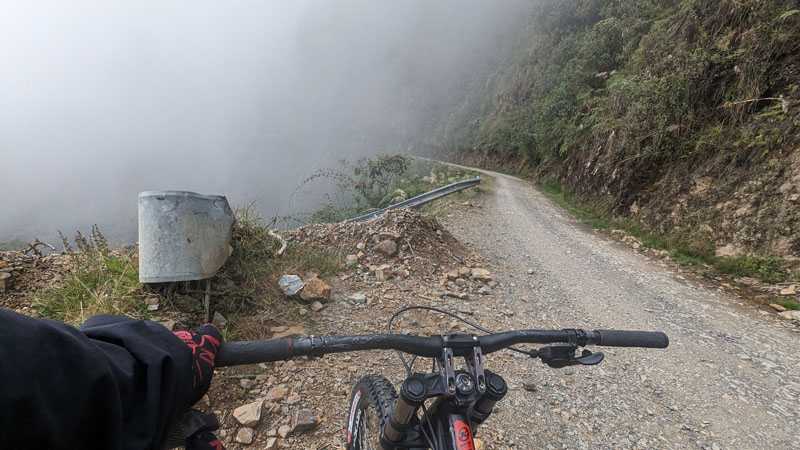
Above: Shortly before broken shoulder on Death Road, Bolivia
Those are some serious high-highs and low-lows. You are clearly committed to making your adventure work. How do you plan where to go next?
We are currently in Ecuador and will probably be in South America for another few months. Then we’ll slowly make our way north until we hit Canada and Alaska. From there we will turn toward Boston and the end of this leg of the journey.
Along the way, there are a few things we want to do; encounter blue-footed boobies in the Galapagos, marvel at the longest single-drop waterfall in Guyana, meet sloths in Costa Rica, drink rum on a beach in Nicaragua, explore the Aztec and Mayan civilizations in Mexico and Central America, and take the longest (actually the second longest) zipline in Mexico.
“Before embarking on the trip we made a giant travel guide for ourselves on Google MyMaps.”
Before embarking on the trip we made a giant travel guide for ourselves on Google MyMaps. Initially, we used Google MyMaps to list all of the places we wanted to go. Now we also use it to mark where we’ve been. Occasionally we add more items to it as we receive suggestions from locals and other travelers. We use this map as our guide to our next destination. Here is a link to our master plan.
Having a master travel plan is a great idea. Do you see yourself going back to an apartment or house again?
Eventually, yes. Our Palomino camper does not have a shower or a toilet, so having access to a clean bathroom on a regular basis would be nice. Additionally, it is important to recharge batteries and ensure that one does not become jaded. There are only so many colonial towns one can see before they all blend into one. A little off-the-road time should fix that.
Our break won’t be a long one. We have caught the travel bug and, since we have successfully mixed work and travel, we may take advantage and go to the 100+ more countries we want to explore.
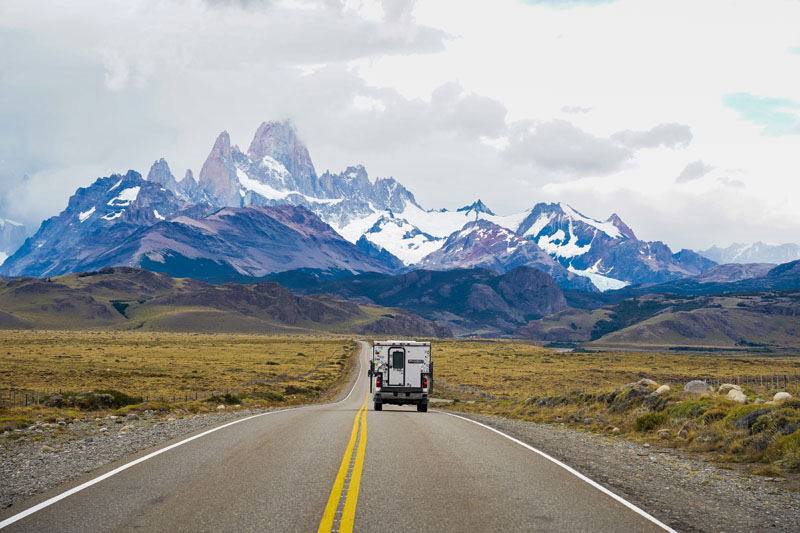
Above: Road to El Chalten, Fitz Roy Mountain, Argentina
If you could go back in time to the day you left your apartment, what advice would you give yourselves?
More storage space! Mounting the camper on a flatbed truck with some additional storage boxes on the outside would have made our lives so much easier. We would also advise ourselves to replace our refrigerator before hitting the road. Our absorption refrigerator could not stand up to the conditions of hotter climates and replacing it before leaving would have saved a lot of time and stress.
The road changes you in unexpected ways; whether it’s priorities, your outlook on life, or your world view. Accepting this personal growth is part of the lifestyle. Maybe we embark on this journey to discover ourselves.
“The road changes you in unexpected ways; whether it’s priorities, your outlook on life, or your world view.”
Martin and Amy’s Rig Information
Truck: 2016 GMC Sierra 2500 HD, gas, 4×4, short bed
Camper: 2016 Palomino SS-1200
Tie-Downs and Turnbuckles: Torklift
Suspension: Air Lift LoadLifter 5000, Bilstein 5100 shocks
Gear: ARB air compressor
